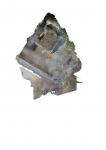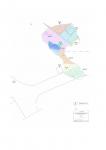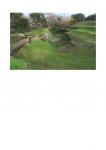Summary (English)
The works planned and carried out in the area of the Porta Sarno necropolis out during this first phase of the 2018 campaign, were the following:
1.-EVALUATION OF THE STATE OF CONSERVATION
We note that since the excavation concluded in early 1999, it had been highly affected by environmental and anthropic factors.
There were frequent visits to the area demonstrated by waste material such as glass bottles, plastic and cans. on the surface and covered by the lapilli fallen from the stratigraphic cuts.
There was some architectural fragments on the curb of the via dell’ Abbondanza that had fallen from its original position, as well as an archaic capital that was on the secondary road. The stuccos of the funerary monuments and the rest of the structures had collapsed almost totally in these 19 years. In the press images it is seen that both the tombs of the praetorians and the funerary monument “a dado” on the podium were completely covered.
Much of the effort of this first has thus been invested in stopping this deterioration and preventing future collapse, which will be explained in the corresponding section, No. 5.
The stratigraphic sections of the excavation, formed by the lava levels that covered the city of Pompeii and the Vesuvian area in 79 AD, were once sheltered with rods, red plastic mesh and wooden planks to protect this fragile material against the inclemencies of the weather and the vibrations produced by the frequent passage of the Circumvesuviana train, but over the years these were collapsing in successive landslides.
Vegetation had also invaded numerous areas that had been cleared from it a few months before as well as on other occasions.2.- CLEANING AND PREPARATION WORK FOR FUTURE INTERVENTIONS
On July 10, 2018, we began the cleaning and documentation of the necropolis, focusing, above all, on the structures affected by the degradation and with restoration needs as well as in the areas considered as priorities for future excavation work. The areas that were most widely cleaned were the following:
• Main road, via dell’Abbondanza, and the secondary road to the city bypass
• Funerary site with a monument “a dado” on a podium
• Funerary site with a collapsed monument “a colonella”
• Two tombs of praetorians
• Possible Samnite area next to the secondary road.
Special attention has been devoted to the cleaning of plants and moss that had grown on the walls, both to stop their deterioration and to be able to carry out the consolidation work and the 3D imaging of the structures.
Zone E was also cleaned from the funerary enclosure with monument “a dado” and it was seen that in zone N there is a wall – UE 1040 – that would have been part of another enclosure located towards the northern area of the excavation that would be already inside the cut stratigraphic Also in zone E, but in part S, there is another small monument similar to the ones near the Praetorians – EU 1039.
The lapilli that were removed during the cleaning process was left in the area that we agreed at the March meeting, to the NO of the excavation area.
Numerous general and detailed photographs of the excavation were made as well as all the structures and stratigraphic levels, before, during and at the end of the cleaning process.
The work concluded with covering with geotextile of the areas that were wanted to preserve in optimal conditions so that at the moment of beginning the excavation in 2019 they are in perfect condition and the work is not slowed down. These areas have been the following:• Interior of the funerary enclosure that has the “a dado” monument on the podium
• Interior of the funerary site that has the collapsed “collonato” monument
• Outside area of the funeral precincts next to the tombs of the praetorians
• Continuation of the pavement or rudus of pebbles and stones- STUDY AND DOCUMENTATION OF THE WALLS
The space of the intervention was divided into different work zones, where the two funerary enclosures known to date in the necropolis stand out: – AREA A: Funerary site with a monument on podium. – AREA B: Funerary site with a monument of type “collonato”.
The area outside these enclosures was also subdivided into several areas: – AREA C: Samnite necropolis. – AREA D: area east of site A. – AREA E: via de l’Abbondanza, E-OE direction. – AREA F: auxiliary road, N-S direction. – AREA G: Funerary monument south of the auxiliary road. – AREA H: Praetorian tombs area. – AREA J: space between the funeral precincts and the area of the Samnite necropolis. – AREA K: space between the two tracks.
As we have already said, the field work consisted solely in the cleanup and preparation of the site, focusing on the structures and above all on stopping the deterioration suffered by these since its discovery in 1998.
Therefore, the work at the level of sediments has consisted in the surface cleaning of the different areas where it is expected to act next year, until reaching the levels at which the excavation ended in 1998, removing the lapilli fallen from the cuts, in these last years, and the vegetation that covered the deposit, very abundant, in some areas.
- Llorenç Alapont (Ilustre Colegio Oficial de Doctores y Licenciados en Filosofía, Letras y Ciencias de Valencia y Castellón, Universidad Europea de Valencia)
Director
- Joaquin Alfonso Llorens (Depatmento de Arqueología CDL Valencia, Universidad Europea de Valencia)
- Llorenç Alapont (Ilustre Colegio Oficial de Doctores y Licenciados en Filosofía, Letras y Ciencias de Valencia y Castellón, Universidad Europea de Valencia)
- Luana Toniolo, Responsable Cientifico (Funzionario Archeologo Parco Archeologico di Pompei)
- Rosa Albiach (Ilustre Colegio Oficial de Doctores y Licenciados en Filosofía, Letras y Ciencias de Valencia y Castellón. Museu Valencià de la Il·lustració i de la Modernitat, Diputació de València)
Team
- Ana Minguelez Gonzalez (Depatmento de Arqueología CDL Valencia)
- Antoni Puig Palerm (Depatmento de Arqueología CDL Illes Balears)
- Danilo De Dominicis (SAMA Archeologia)
- Grace Kathleen MCkenzie-Mcharg (University of Melbourne)
- Mª Dolores Sanchez de Prado(Universidad de Alicante)
- Pedro Corredor Peinado (Depatmento de Arqueología CDL Valencia, Universidad Europea de Valencia)
- Pilar Mas Hurtuna (Depatmento de Arqueología CDL Valencia, Universidad Europea de Valencia)
- Sarah F. Evans (University of Cincinnati)
- Victor Revilla Calvo (Universidad de Barcelona)
- Vincenzo Sabini (Assistente di Scavo - Soprintendenza Pompei)
- Fabio Mestici (SAMA Scavi Archeologici)
- Alfio Giannotti (istituto d'arte f.menna)
- Beatriz Hernáez Saceda Carolina Lopez Andrés Tania Sáez Girbés Ana Isabel Chacartegui Lara Daniella Jacques Charlotte Sabaux Danielle Munro V Dominik Göldner Leah Böttger Farrell Monaco Marine Schlachter Karen Maree Oliver Kathleen Joy Fisher Charles Malcolm Avery Andrezza Alves Spexoto Olival Robert Sirico (Acton Institute)
- Ilaria Frumenti (Università degli Studi Roma Tre)
- Pasquale Longobardi (Studio Longobardi) – Health and Safety Officer
Research Body
- British School at Rome
- Ilustre Colegio Oficial de Doctores y Licenciados en Filosofía, Letras y Ciencias de Valencia y Castellón
- Universidad Europea de Valencia
Funding Body
- Ilustre Colegio Oficial de Doctores y Licenciados en Filosofía, Letras y Ciencias de Valencia y Castellón






![Download [PDF]](/excavation/skins/fasti/images/results/download_sml.png)

